As an Amazon Associate I earn from qualifying purchases.
OK, so you’ve had a banner day and shot your limit of ducks, probably with a whole bunch of bonus geese. Now what do you do? Here’s how to clean a duck, as well as everything you need to know about processing, breaking the birds down, and how you can use pretty much everything but the quack when you’re eating ducks. Ready? Here we go!
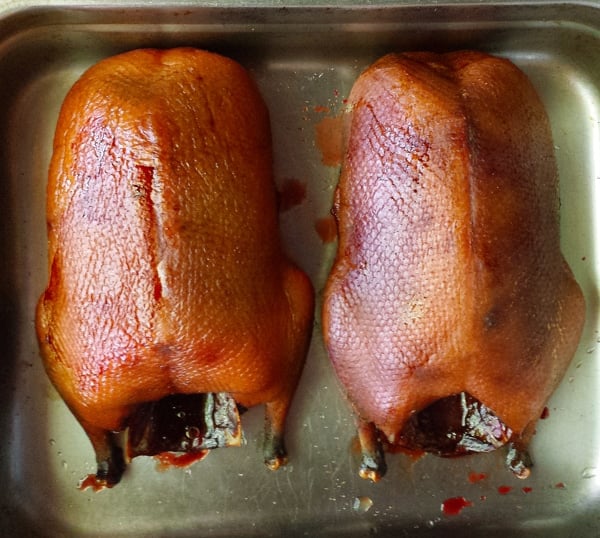
First the birds need to be aged, plucked or skinned. Generally I don’t age waterfowl too long, because our birds tend to be fat, and duck fat goes rancid fairly fast unless you hang the birds in temperatures under 50°F. But at those temperatures, aging takes a long time.
I wrote extensively on hanging game here if you want more detail.
My general practice is to let the birds sit in a cool place for 1 or 2 days, often in the fridge, then pluck or skin. You can keep waterfowl in the fridge for up to a week, though.
How to Clean a Duck
When it comes time to decide whether to skin or pluck, it depends on the bird. Sea ducks and divers shot over salt water I almost always skin. I also skin most snow geese, and spoonies (a/k/a shovelers) if their skin is orange; orange skin and fat means the birds have been eating crustaceans and will be fishy. The color is the same thing that turns a salmon’s meat orange.
For step-by-step instructions on skinning, Holly and I made a video on how to skin a duck.
We pluck most birds, though. There are lots of ways to pluck birds, but we use paraffin wax and a hot-cold water bath. For why you ought to consider plucking more birds, and not just waterfowl, read here. We also made a video on how to pluck a duck, too, so you can see how we do it.
Our method of plucking takes about 10 to 20 minutes per bird, depending on how skilled you are or the size of the bird. Diver ducks are harder to pluck than puddle ducks, and snow geese are harder than specklebelly geese or Canadas.
Once plucked or skinned, gutting is easy. I take kitchen shears and clip off the feet, then chop off the head and the second joint on the wing (I toss the wingtips). I save most of them; more on that later. Then I use the shears to chop off the tail, taking care to not damage the gizzard. I save the tail, too.
After that I get some cold water running and then reach into the cavity and grab the gizzard. This usually pulls out the intestines, too. I toss the intestines and keep the gizzard. (Here is a video on how to clean the gizzard).
That leaves the heart and liver. I gently reach inside and with my fingers dislodge any connective tissue holding the liver in place, then pull it and the heart out. I trim the top part of the heart off, right above the ring of white fat.
For the livers, you need to remove the bile duct, which looks like a green Nyquil gel cap. I gently pinch this away from the liver under cold water without breaking it — if you break it, the bile fluid is very bitter and can spoil the liver, thus the running water.
After that, a quick rinse and the duck is ready for the fridge. I pat them dry with paper towels and put them in a closed plastic container in the refrigerator for up to a week before freezing. I always will keep them at least overnight to firm up the fat. Once they’ve aged a bit in the fridge — they dry out a little, like dry-aged beef — I vacuum-seal them and freeze.
Oh, and those heads and feet I’m saving? I cut out the tongues, which are used a lot in Chinese cooking. I have a great recipe for crispy fried duck tongues. The feet go into my duck broth. Feet have collagen, and, once you hack them up with a cleaver or kitchen shears, that collagen is released into the broth, making it thicker and richer without adding fat.
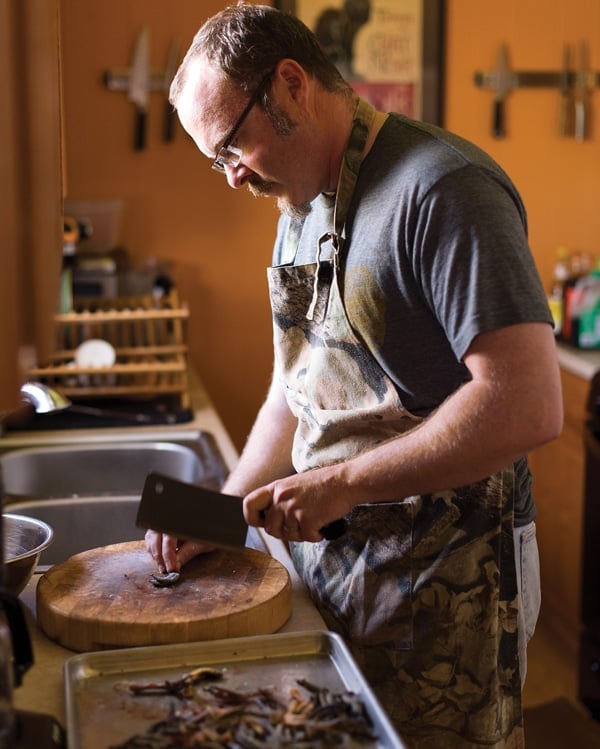
Eating Everything But the Quack
Over the years, I have learned that when it comes to eating ducks and geese, you can eat pretty much everything but the quack.
I have grown used to the funny looks I get from hunters who typically just cut out the breast meat on their birds. Hell, I even get funny looks from people who pluck their birds. I can’t help it. I shot these ducks. They’re dead because of me. The least I can do is not waste them.
So what can you do with all these lovely bits of bird?
Well, we all know how lovely a perfectly cooked duck breast can be, and most of us know that duck legs are wonderful braised or made into confit. But what about the wobbly bits?
Hearts can be eaten in several ways, either sliced and stir-fried, or braised for a long time. I am fond of deviled duck hearts. I actually make a raw, duck heart tartare that is one of the dishes I make in cooking competitions a lot — it has never failed to impress. If this is a bit much for you, use the hearts in your broth-making or add them to your ground up duck for meatballs or duck burger.
Gizzards are destined for the stockpot if they are small, such as those from teal or spoonies. If they are large — and especially goose gizzards — I clean them, trim them and make them into confit. I learned this trick from Paula Wolfert in her The Cooking of Southwest France. If you hunt ducks and don’t have this book, you are missing out on a lot. Trust me.
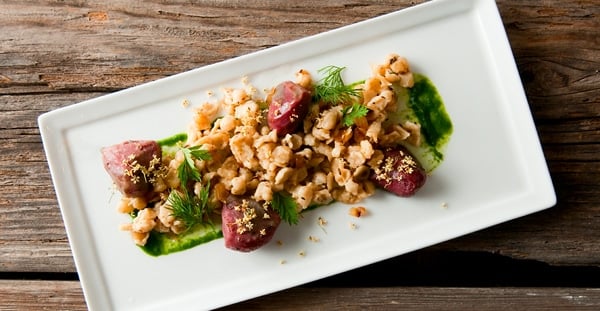
In general, gizzards need to be cooked for a long, long time. Like overnight kind of long. My favorite gizzard dish is where I “corn” the gizzards like corned beef and then cook them gently for a full day in a SousVide Supreme. It is a magical, mystical dish.
You can also fry gizzards, the way they do in Montana, or add them to your duck broth. Once cleaned and ground up, they’re a great addition to sausage. I’ve actually designed a duck giblet sausage specifically for this.
Livers had always been a problem for me. I don’t like the texture of liver, although I like the flavor. There is one exception, however, and that is when we get a “wild foie gras,” a liver that has grown large and fat from the bird gorging itself on rice or whatever. These livers are spectacular seared simply and served with good balsamic vinegar and salt.
Normally I make duck liver ravioli; my recipe is inspired by Mario Batali’s Babbo Cookbook, which has a similar version. Livers are also excellent in pâté. I am experimenting with a couple German liver recipes — liver dumplings (leberknoedel) and a liver sausage like liverwurst. I’ll post on them when I get the recipes just right.
Now we get to the weirder parts of eating ducks.
If you happen to have a mallard, pintail or goose, you should try saving the neck skin. What I do is push out the bones and meat (they go into the stockpot), then clean the inside of the skin, pull out the windpipe and voila! You have the greatest sausage casing Nature has ever devised. I came up with this idea all by myself and was so proud of it — until I later read that those damn French have been doing it with geese for centuries. Nothing new under the sun. You’ll find more on making sausages with a bird’s neck here.
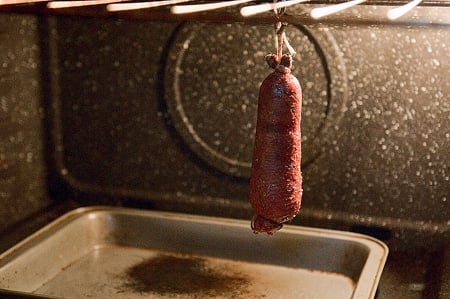
I’m not done yet. Not by a long shot. Wild duck fat, anyone?
As it happens, the tails — the Pope’s nose — on ducks and geese are typically very, very fatty. And one of the great joys of eating wild ducks is that they are among the precious few wild animals blessed with copious amounts of delicious fat; the fat under the skin is why you never skin a duck breast unless that fat is fishy-tasting. So what do I do with the various Pope’s noses? I hack them to bits and render the duck fat. I got a cup and a half from the batch of 15 ducks Holly and I shot that opening weekend back in 2008, and that is not uncommon. I once got 1/2 cup of white, sweet-tasting fat from one drake pintail.

Be sure to use the tails from puddler ducks or seed-eating ducks. Don’t use divers, and be careful about spoonies — they can be fishy. My advice is to start with pintails and teal, then move to wigeon and mallards. Gadwall are up to you; if you like gadwall flavor, add them. Here is how I render duck or goose fat.
And then, when you are left with duck cracklins’, you can stew them in Mexican salsa verde to make the classic dish chicharron en salsa verde, which is amazing on a corn tortilla.
For those of you who do not hunt, keep in mind this guide to eating ducks works with domestic ducks and geese just as well as it does with the birds we bring home from the marsh. And for those of you who do hunt, I hope this gives you a little inspiration to do something a little different with your birds this year. May you shoot well and lose none!
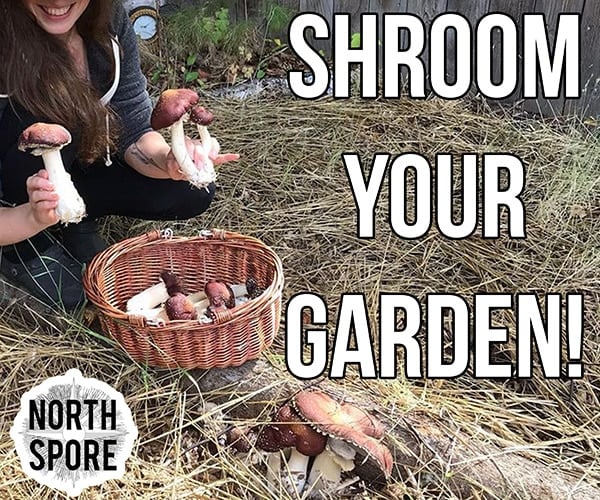


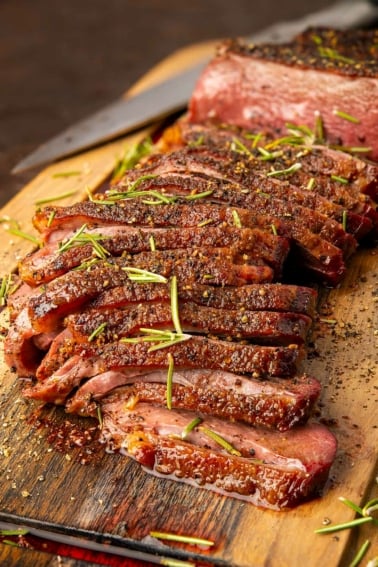
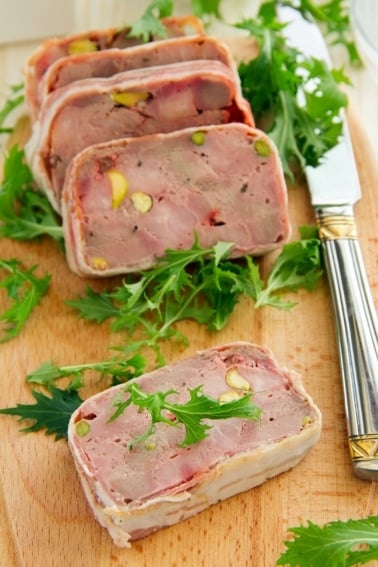

Hank,
I just learned about the uropygial gland (also known as the preen gland or oil gland) in the tail of ducks. I’m wondering if you remove these before rendering fat or just leave them in?
Brandon: I’ve done both. I cut them out if I am eating the cracklins (quacklins?), and leave it in if I’m just getting the fat. I have never noticed it to change the flavor of the fat, and I have rendered many many gallons of duck fat.
thanks for the deep dive on duck – I typically only hunt upland birds, but I have a pointer that is a hunting machine – deadly steady on upland birds – but when we sometimes train near a duck pond, he sometimes brings me one, alive – and typically unbruised, but not always – if it can get away on its own, I let it go, if not … conservation of game – well anyway, all that info. on innards is fascinating, but like I do with our upland game birds, those bits go to the dogs, usually raw, but we do make stew for them too – thanks again – PS: can’t stop my pointer from always hunting
Hi!
I love all the information you provided on preparing duck.
I accidentally left three ducks in the back of the truck for 6 hours. It was a sunny day and 55 degrees.
The ducks had been plucked and gutted. They were under ice, but it had melted by the time I remembered. I got them in the freezer right away. Will these still be safe to eat?
Thanks,
Susan
Susan: I would guess so, but your nose is your best ally here.
Hank,
Love your stuff. Seared some mallard breasts a bit back according to your method and had great results.
Had a question on rendering fat.
According to one site, I read that the pope’s nose ” includes the uropygial gland that produces the oil the bird uses to preen itself with.”.
Because of this, they say to not use this portion of the bird because it will leave a bitter taste. Should we remove the gland? Is there a way to do this?
Thoughts on this?
Ken: I’ve done it both ways, and to be honest, have never noticed the difference. It might be bitter to eat, but it sure doesn’t mess up the oil. But if you are worried about it, snip it out with kitchen shears. It’s big and obvious. You’ll see it.
Sorry – my other post went away. I don’t know if it went to you or not… I did find your dry plucking video and it’s very helpful! but i have to figure out if I can clean the down after and use it.
I am excited about your duck and goose cookbook – checking out recipes now. Thank you so much for such helpful material!!
This is helpful, thanks! I have some backyard ducks & got 3 drakes this year (had 13 ducklings and sold 10. of course all 3 I kept had to be boys when my friend wanted a pair!) SO I will need to butcher them up at some point. I’m glad I have friends with equipment who can show me how to do it the first time. I’ve actually never eaten duck so I don’t even know if I will like it. Guess we’ll find out. They’re half Cayuga which is on the ‘slow ark of food taste’ and supposed to be delicious, but I have eaten supermarket flavors all my life, so I’m used to bland!
meanwhile another friend’s family has been hunting and i asked if they ever keep the down from the eiders. They only eat the breasts and toss the rest, so he brought a bunch to the gym in the back of his truck and said i can have them. I’m going to try to pluck the down and save it to make a small pillow or something… or add more to it from my own birds, perhaps, and eventually have enough to do something more substantial.
do you ever keep the down when you pluck? I understand normally the meat is the point so wax-plucking or mechanical plucker is the best option, but with only a few at a time I’m hoping it won’t be too terrible…especially with the ducks i was given that already have the meat off them.
JJ: No, I don’t keep the down, sorry.
Does all of this apply to geese as well? Ie popes nose on a goose? Rendering fat? Got some early season Canada’s and sorting out how to deal with them.
Thanks!
Charlie: Yes it does. Geese are just as good as ducks in this respect.
Should wild ducks and geese be frozen before or after brining?
Paul: I rarely brine ducks and geese. But when I do, it is after freezing and before cooking.
First time with duck ? where do I start ?
Great page.
Is there a proper way to prepare goose hearts for freezing?
Michael: No special way. I just put them in plastic wrap and then in a freezer bag.
Thanks for info. Have not hunted ducks/geese but would like to- love to cook – was wondering how they are handled as friends do a lot of bird hunting. Want to share liver recipe – cost liver with a little flour/ pepper. Fry in EVO add
powdered ginger, sugar, soy sauce( onion – shallots if you want). Really delicious
First of all a huge thank you for all the insight on taking wild game from the field to the table. Quick question on temperature management from kill to processing. I prefer to hang my ducks 2-5 days guts in. I haven’t had any issues saving and eating the giblets this way. However on warmer days…say 45 and up…I get a little gun shy and often toss the innards. Many of the spots we hunt are a fair drive from home and if it starts to warm up around 10 am or so it may be 3 pm before I get them into a temperature controlled environment. To be clear on early season days (teal season) when it can be into the 80s I treat them differently, speaking to days that are into the 40s to mid 50s mostly. What, if any, food safety rules am I violating?
Tom: None that I know of. You are doing pretty much what I do, although I don’t hang ducks for 5 days very often.
I shot a Canada Goose on Saturday morning at about 10am.
it was about 41 degrees F outside according to acu-weather.
I did get some shot in the belly region. I carried it in a small duffel all by itself until I got back to the truck. When I got it back to the truck, I put it in the cooler with ice. When I got it home I put it in another big cooler with ice and forgot about it overnight. The next evening I decided to clean it. I began to pluck it and then gutted it. I noticed that it had a somewhat unpleasant smell to it. Not rancid but rather foul like a dirty animal. I rinsed it off with cold tap water and patted it dry with paper towels and put in the fridge in a zip-lok bag.
My question: given the temp. Time. and the fact that the shot spread over the whole body, is it still safe to eat?
Donald: you’re fine. The insides of Canada geese are notoriously stinky.
Ok I’ll take your word for it, thanks. My husband thanks you too.
This is my first year raising ducks myself and I have five drakes that we’re planning on butchering in the very near future. I want to use every part of them, and I was wondering if there was a particular reason why you throw away the intestines. I was thinking morcilla for the blood and intestines but I’ve never heard of a non-pork version and I figure there’s an obvious reason that I don’t know about.
Megan: The obvious reason is they are full of shit and very narrow. Yes, it is in theory possible to do what you are planning, but I wouldn’t.
You should skin out the ducks I shot a mallard this morning and it had rice breast. That’s a parasite. From what I researched you can eat it still but I think I will pass on it after seeing the pictures and actually seeing it in person. Kinda turned my stomach.
Wesley: I know about rice breast, but it is an oddly localized parasite. In some places it’s common, some places not so. Where do you hunt? And there is no reason to skin out ducks just out of fear of rice breast: If you pluck, then break them down, you can see if your duck has rice breast on the meat side of the breasts.
Kudos on that philosophy “they are dead because of me, the least i could do is not waste them”! That’s my philosophy too. One quick question: have you found parasites in your ducks? If so, how safe is to eat the gizzard, heart, liver and stuff!? I ran in to lots of worms this season. All of them in the intestines, but still, makes you think twice!
Johnny: I rarely see parasites in my ducks, although it can happen. If I saw them, I’d make sure to thoroughly cook the giblets.